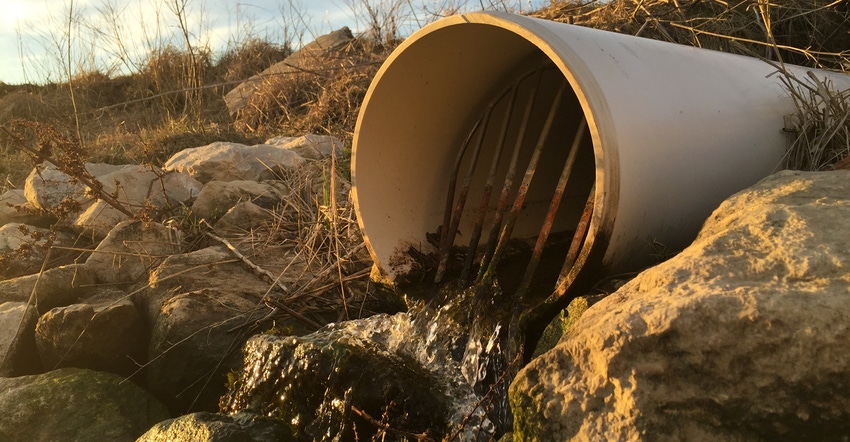
Illinois isn’t currently on track to meet reductions in nutrient loss from nonpoint sources in agriculture, but there is progress.
According to the Illinois Nutrient Loss Reduction Strategy report released at the end of November by the Illinois Environmental Protection Agency and the Illinois Department of Agriculture, nitrate losses are up an average 7% in 2013-17 compared to 1980-96. Phosphate losses are up 26%.
Part of the nutrient increase can be pinned to another number: a 13% increase in river flow during the same period. Heavier rains and wetter conditions in Illinois cause more phosphorus-bound soil particles to move off-field. On tile-drained land, more nitrates move through drainage, though the increase is less pronounced
“The report highlights many areas where substantial efforts in the ag sector did result in some reductions,” says Jean Payne, president of the Illinois Fertilizer and Chemical Association. “That progress can get overlooked if you only focus on the total numbers in the report. For example, several rivers, including the Illinois River, showed slight decreases in nitrate levels in 2017-18, despite the higher water flow.”
The goal for 2025 is to cut total phosphorus by 25% and nitrate and nitrogen by 15%. And the ultimate goal, which has no date on it, is a 45% reduction in total phosphorus and total nitrogen, says Jill Kostel, steering committee leader for the Illinois Sustainable Ag Partnership and senior environmental engineer with the Wetlands Initiative.
She says the state isn’t on track to meet the 2025 goal for nitrate reduction set by the Nutrient Loss Reduction Strategy. But thanks to upgrades at wastewater treatment plants, Illinois point-source phosphorus pollution should go down by close to 25% within five years.
Illinois had 318,636 acres in cover crops in 2012, and that number increased to 708,105 acres in 2017 — a 122.2% increase, according to the USDA census. Kostel estimates adoption increased during 2018 and 2019 as well, in part because of prevented planting.
However, the Illinois Stewardship Alliance estimates it would take a million new acres of cover crops per year until 2025 to meet the state’s nutrient pollution reduction goals based on the agricultural censuses in 2012 and 2017. Kostel stresses that cover crops like cereal rye ahead of soybeans can stop up to 40% of the nitrate loss problem on tile-drained land, but having edge-of-field practices like constructed wetlands or bioreactors can help treat water further down the pipe.
Options other than cover crops
Kostel designed a wetland that’s part of a cover-cropped farm at Illinois Central College. The farm also uses a bioreactor with the goal of nearly zeroing out nutrient loss.
“For us, since the constructed wetland is one of the most expensive practices in terms of tile treatment, the current rate payment the Conservation Reserve Program pays does not cover enough of the cost to say, be encouraging to farmers to take this on their own,” Kostel says, adding that because the Natural Resources Conservation Service is still interpreting the 2018 Farm Bill, farmers are waiting to enroll in her four-wetland-strong Wetlands Initiative.
“Some farmers are waiting to see if we can get higher rate payments,” Kostel says. NRCS can designate up to 10 priority conservation practices for higher rate payments.
IDOA is also paying $300,000 in 2020 for a $5-per-acre reward for cover crop users in priority watersheds identified by the Nutrient Loss Reduction Strategy.
“We’ll see how this cover crop rebate works,” Kostel says. “We’re definitely moving in the right direction. It’s going to take a couple years to ramp up implementation of not just cover crops, but other practices. It’s going to be important to provide technical resources and assistance for farmers and landowners to make the best decision for their operation.”
She stresses the importance of ensuring the state funds soil and water conservation districts so they can give advice, and even lend seed drills for cover crops or burn equipment for mid-contract management on filter strips and pollinator habitat.
“They only have a limited pot of money, but Illinois government put money into cover crops, which is great, so the idea is to maintain and increase that pot of money every year to encourage farmers,” Kostel says of the state’s limited efforts to reward farmers for planting cover crops.
Grant Hammer, executive director of the Association of Illinois Soil and Water Conservation Districts, says the cover crop reward and a slight increase in funding for districts is a sign there’s reason to be optimistic about making progress meeting nutrient loss goals.
“The state’s 2015 strategy for rolling back nutrient losses coincided with the state of Illinois’ budget crisis, which spanned three budget cycles,” Hammer says. “During this time, funding for soil and water conservation programs dried up, and as a result, the state lost nearly one-half of soil and water conservation district personnel. There is reason for optimism. Policymakers in Springfield are gaining greater familiarity with the issue.”
Precision Conservation Management, a service of the Illinois Corn Growers Association, is taking anonymous conservation practice data from hundreds of farmers stretched across 16 counties in Illinois and 10 in Kentucky to help show the value of conservation, such as how fewer tillage passes save money on fuel and often result in the same yields.
PCM recently won a USDA grant to build out a framework for a national soil health database.
“With our partners at PCM, we may be able to help farmers identify areas that they’re not making money on — maybe they’re losing money. So if we put that land into a conservation practice, maybe the payment helps the bottom line overall, because they’re not investing inputs into that negative revenue area,” Kostel concludes.
About the Author(s)
You May Also Like




